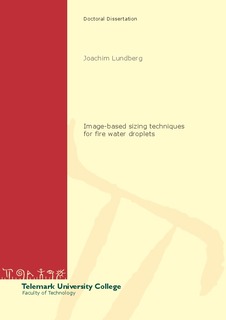| dc.contributor.author | Lundberg, Joachim | |
| dc.date.accessioned | 2015-12-15T20:55:14Z | |
| dc.date.accessioned | 2017-04-19T12:10:47Z | |
| dc.date.available | 2015-12-15T20:55:14Z | |
| dc.date.available | 2017-04-19T12:10:47Z | |
| dc.date.issued | 2015-11-12 | |
| dc.identifier.citation | Lundberg, J. Image-based sizing techniques for fire water droplets. Doctoral dissertation, Telemark University College, 2015 | |
| dc.identifier.isbn | 978-82-7206-402-9 | |
| dc.identifier.issn | 1893-3068 | |
| dc.identifier.uri | http://hdl.handle.net/11250/2437784 | |
| dc.description.abstract | The Norwegian petroleum industry has developed a standard for the technical safety of offshore installations (NORSOK S-001, 2008). When dimensioning accidental load with this standard, the deluge or fire water spray may be considered as a risk reducing measure for equipment and pipes, but not for the structural elements or fire partition (NORSOK S-001, 2008). Proper documentation of the suppression effect and reliability has to be provided when water is used as a fire risk reduction measure in risk evaluation. The standard states that the deluge system shall be automatically activated upon confirmed gas detection when used for explosion mitigation. Full-scale fire experiments with fire on offshore platforms are limited by practical and economic considerations. Instead, numerical simulations are used for risk analyses. To get a good representation of the effect of the fire water deluge system, the properties of the water spray need to be known. In the literature, the availability of data on fire water spray is limited. Often the spray is described only by the orifice diameter of the fire water nozzles and spray angle. However, the flow properties of the spray (i.e., size and velocity distribution of the droplets) are known to influence the suppression efficiency. Small droplets will follow the convective forces in the gas flow, evaporate quickly, cool the fire gases and screen for heat radiation. In contrast, large droplets have high momentum and are more likely to reach the source of the fire and to cool objects such as process equipment and pipes. Presently the most used technique for measuring droplet size and velocity in fire water spray is the Phase Doppler Anemometry (PDA). This technique will provide online measurements of both size and velocity at the same time, but the technique has some limitations and practical problems. In this doctoral thesis, a laser-based shadow-imaging technique by a high-speed camera and a laser is used. To analyze the shadow-images, an in-house image-processing tool in Matlab has been developed to find droplet size- and velocity distribution. The results from the experiments in this thesis show the location in the spray to have a large effect on the water flux(𝑑𝑚3⁄(𝑚2 ∙ 𝑚𝑖𝑛)), i.e. the water flux is not uniform and varies with water supply pressure. The geometry of the nozzle and the frame arms affects the applied water flux extensively at low pressures. This effect is taken into account when the applied water flux is measured. The results show the water pressure to have the following effects: The radial coverage will decrease with increasing water supply pressure The applied water flux will be less uniform for different azimuthal angles at low water pressures than at high water pressures. The number of large droplets will decrease with increasing pressure The velocity of the droplets will in general increase with increasing pressure. The research provides unique experimental data of droplet size- and velocity distribution for the fire water nozzle and an image processing software to analyze shadow-images from a laserbased shadow-imaging technique. The results have been facilitated for adoption to CFD-tools. | |
| dc.language.iso | eng | |
| dc.publisher | Telemark University College | |
| dc.relation.ispartofseries | Doctoral dissertations at TUC;2015:5 | |
| dc.relation.haspart | Paper I: Lundberg, J., Lysaker, O.M., Vågsæther, K. & Bjerketvedt, D. (2013). Image-Based Characterization of a Medium Velocity Fire Water Nozzle ??Preliminary Results. ISFEH7 Fire and Explosion Hazards. Proceedings of the Seventh International Seminar 5-10 May 2013 Providence, RI,USA, p. 492-500. Singapore: Research Publishing Services, 2013. Full text not available due to publisher restrictions. The published version is available at http://dx.doi.org/10.3850/978-981-07-5936-0_07-06 | |
| dc.relation.haspart | Paper II: Lundberg, J., Lysaker, O.M., Vågsæther, K. & Bjerketvedt, D. (2014). Characterization of deluge spray with image processing. Tenth International Symposium on Hazards, Prevention, and Mitigation of Industrial Explosions Bergen, Norway, 10-14 June 2014. Full text not available due to publisher restrictions. | |
| dc.subject | fire water spray | |
| dc.subject | deluge | |
| dc.subject | droplets | |
| dc.subject | image processing | |
| dc.title | Image-based sizing techniques for fire water droplets | |
| dc.type | Doctoral thesis | |
| dc.type | Peer reviewed | |
| dc.description.version | Published version | |
| dc.rights.holder | © Copyright The Author. All rights reserved | |
| dc.subject.nsi | 553 | no |
| dc.subject.nsi | 581 | no |
